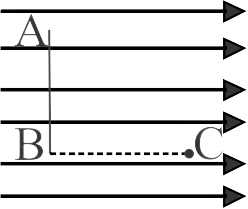359558
A uniform electric field of magnitude \({325 {~V} / {m}}\) is directed in the negative \({y}\) direction in figure. The coordinates of point \({A}\) are \({(-0.2 {~m},-0.3 {~m})}\) and those of point \({B}\) are \({(0.4 {~m}, 0.5 {~m})}\). Calculate the potential difference \({V_{B}-V_{A}}\) along the path shown in the figure.
359560
Figure shows three points \(A\), \(B\) and \(C\) in a region of uniform electric field \(E\). The line \(AB\) is perpendicular and \(BC\) is parallel to the field lines. Then which of the following holds good? (\({V_A},{V_B}\,{\rm{and}}\,{V_C}\) represent the electric potential at points \(A\), \(B\) and \(C\) respectively)
359561 Determine electric potential difference (in \(V\)) between points \(A\) and \(B\) in an uniform electric field \(\vec E = (2\hat i + 3\hat j + 4\hat k)N{C^{ - 1}}\) where \(\overrightarrow {{r_a}} = (\hat i - 2\hat j + \hat k)m\) and \(\overrightarrow {{r_b}} = (2\hat i + \hat j - 2\hat k)m\)
359558
A uniform electric field of magnitude \({325 {~V} / {m}}\) is directed in the negative \({y}\) direction in figure. The coordinates of point \({A}\) are \({(-0.2 {~m},-0.3 {~m})}\) and those of point \({B}\) are \({(0.4 {~m}, 0.5 {~m})}\). Calculate the potential difference \({V_{B}-V_{A}}\) along the path shown in the figure.
359560
Figure shows three points \(A\), \(B\) and \(C\) in a region of uniform electric field \(E\). The line \(AB\) is perpendicular and \(BC\) is parallel to the field lines. Then which of the following holds good? (\({V_A},{V_B}\,{\rm{and}}\,{V_C}\) represent the electric potential at points \(A\), \(B\) and \(C\) respectively)
359561 Determine electric potential difference (in \(V\)) between points \(A\) and \(B\) in an uniform electric field \(\vec E = (2\hat i + 3\hat j + 4\hat k)N{C^{ - 1}}\) where \(\overrightarrow {{r_a}} = (\hat i - 2\hat j + \hat k)m\) and \(\overrightarrow {{r_b}} = (2\hat i + \hat j - 2\hat k)m\)
359558
A uniform electric field of magnitude \({325 {~V} / {m}}\) is directed in the negative \({y}\) direction in figure. The coordinates of point \({A}\) are \({(-0.2 {~m},-0.3 {~m})}\) and those of point \({B}\) are \({(0.4 {~m}, 0.5 {~m})}\). Calculate the potential difference \({V_{B}-V_{A}}\) along the path shown in the figure.
359560
Figure shows three points \(A\), \(B\) and \(C\) in a region of uniform electric field \(E\). The line \(AB\) is perpendicular and \(BC\) is parallel to the field lines. Then which of the following holds good? (\({V_A},{V_B}\,{\rm{and}}\,{V_C}\) represent the electric potential at points \(A\), \(B\) and \(C\) respectively)
359561 Determine electric potential difference (in \(V\)) between points \(A\) and \(B\) in an uniform electric field \(\vec E = (2\hat i + 3\hat j + 4\hat k)N{C^{ - 1}}\) where \(\overrightarrow {{r_a}} = (\hat i - 2\hat j + \hat k)m\) and \(\overrightarrow {{r_b}} = (2\hat i + \hat j - 2\hat k)m\)
359558
A uniform electric field of magnitude \({325 {~V} / {m}}\) is directed in the negative \({y}\) direction in figure. The coordinates of point \({A}\) are \({(-0.2 {~m},-0.3 {~m})}\) and those of point \({B}\) are \({(0.4 {~m}, 0.5 {~m})}\). Calculate the potential difference \({V_{B}-V_{A}}\) along the path shown in the figure.
359560
Figure shows three points \(A\), \(B\) and \(C\) in a region of uniform electric field \(E\). The line \(AB\) is perpendicular and \(BC\) is parallel to the field lines. Then which of the following holds good? (\({V_A},{V_B}\,{\rm{and}}\,{V_C}\) represent the electric potential at points \(A\), \(B\) and \(C\) respectively)
359561 Determine electric potential difference (in \(V\)) between points \(A\) and \(B\) in an uniform electric field \(\vec E = (2\hat i + 3\hat j + 4\hat k)N{C^{ - 1}}\) where \(\overrightarrow {{r_a}} = (\hat i - 2\hat j + \hat k)m\) and \(\overrightarrow {{r_b}} = (2\hat i + \hat j - 2\hat k)m\)
359558
A uniform electric field of magnitude \({325 {~V} / {m}}\) is directed in the negative \({y}\) direction in figure. The coordinates of point \({A}\) are \({(-0.2 {~m},-0.3 {~m})}\) and those of point \({B}\) are \({(0.4 {~m}, 0.5 {~m})}\). Calculate the potential difference \({V_{B}-V_{A}}\) along the path shown in the figure.
359560
Figure shows three points \(A\), \(B\) and \(C\) in a region of uniform electric field \(E\). The line \(AB\) is perpendicular and \(BC\) is parallel to the field lines. Then which of the following holds good? (\({V_A},{V_B}\,{\rm{and}}\,{V_C}\) represent the electric potential at points \(A\), \(B\) and \(C\) respectively)
359561 Determine electric potential difference (in \(V\)) between points \(A\) and \(B\) in an uniform electric field \(\vec E = (2\hat i + 3\hat j + 4\hat k)N{C^{ - 1}}\) where \(\overrightarrow {{r_a}} = (\hat i - 2\hat j + \hat k)m\) and \(\overrightarrow {{r_b}} = (2\hat i + \hat j - 2\hat k)m\)
